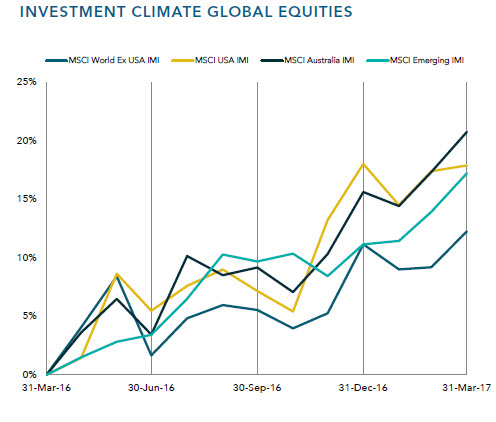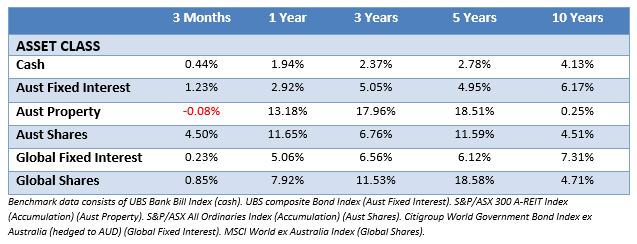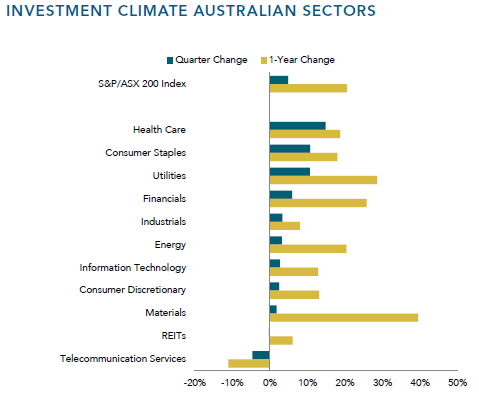Economic Overview
Global policy makers expressed a cautious welcome for continuing signs of improving activity during the March quarter. The Reserve Bank of Australia noted a pick-up in global trade and industrial production, alongside a tightening of labour markets.
In the US, economic data continued to be supportive. Non-farm payrolls were robust and activity indicators buoyant. Manufacturing purchasing managers’ index (PMI) increased and the consumer confidence index rose to its highest level in 16 years.
Reflecting the improving outlook for growth and inflation the Federal Reserve increased rates by 0.25% in March. Optimism over Donald Trump’s plans to cut taxes, boost infrastructure and reduce the regulatory burden, however, the failure to pass changes to healthcare legislation raised doubts over Trump’s ability to implement some of his policies.

In the Eurozone, the period started on a weak note, with negative returns in January, but sharemarkets picked up as the quarter progressed. Economic data released during the period was largely positive. Leading indicators showed gains with the flash composite purchasing managers’ index reaching a near six- year high of 56.7 in March. Inflation, as measured by the consumer price index, picked up to 2.0% in February, albeit slipping back to 1.5% in March.
he Bank of England upgraded its 2017 UK GDP growth projection (from 1.4% to 2.0%) due to stronger-than-expected consumer spending following the “leave” decision in the EU referendum.
After weakening at the end of 2016, the Japanese yen appreciated gradually in the past three months. From Japan’s perspective, the main political event was the meeting between Prime Minister Abe and President Trump which was surprisingly cordial despite the previous US rhetoric around trade and Japan’s foreign exchange policy.
In China, better-than-expected data and a stabilizing yuan led to improved sentiment among investors. Ongoing restrictions on the property market and a tightening on capital outflows also saw liquidity diverted into equities.
Energy was a commodity laggard. Crude oil fell 6% over the quarter amid doubts over the sustainability of an OPEC-led output deal. Oil producers Norway and Russia were the worst performing developed and emerging markets respectively.
Market Overview
Asset Class Returns
The following outlines the returns across the various asset classes to the 31th March 2017.

Global equity markets delivered mostly positive returns, led by emerging markets. The Australian market was a top performer, with healthcare companies being a standout with consumer staples following. However, a stronger Australian dollar trimmed gains from other developed markets for unhedged investors.
US equities performed well as the S&P 500 advanced 6.1%, Information technology was the top-performing sector, followed by consumer discretionary and healthcare.
The quarterly earnings season was a positive one for European equities, with many firms reporting double digit earnings growth and confident outlooks for 2017. The information technology sector was the top performer, followed by utilities and industrials.

The Japanese sharemarket traded in a tight range throughout the quarter, registering a total return of just 0.6%. In China, stocks gained strongly and had their best first quarter in over 10 years, driven on by continued positive news for the world’s second-largest economy.
The emerging markets posted strong gains, with US dollar weakness providing a tailwind for returns. Real Estate Investment Trusts experienced negative returns for a second consecutive quarter, although this came after several years of strong gains.
With thanks to DFA Australia.
Want to learn more about investing? Your Investment Philosophy is Australia’s best investment book, get it today. This material is provided for information only. No account has been taken of the objectives, financial situation or needs of any particular person or entity. Accordingly, to the extent that this material may constitute general financial product advice, investors should, before acting on the advice, consider the appropriateness of the advice, having regard to the investor’s objectives, financial situation and needs. This is not an offer or recommendation to buy or sell securities or other financial products, nor a solicitation for deposits or other business, whether directly or indirectly.




